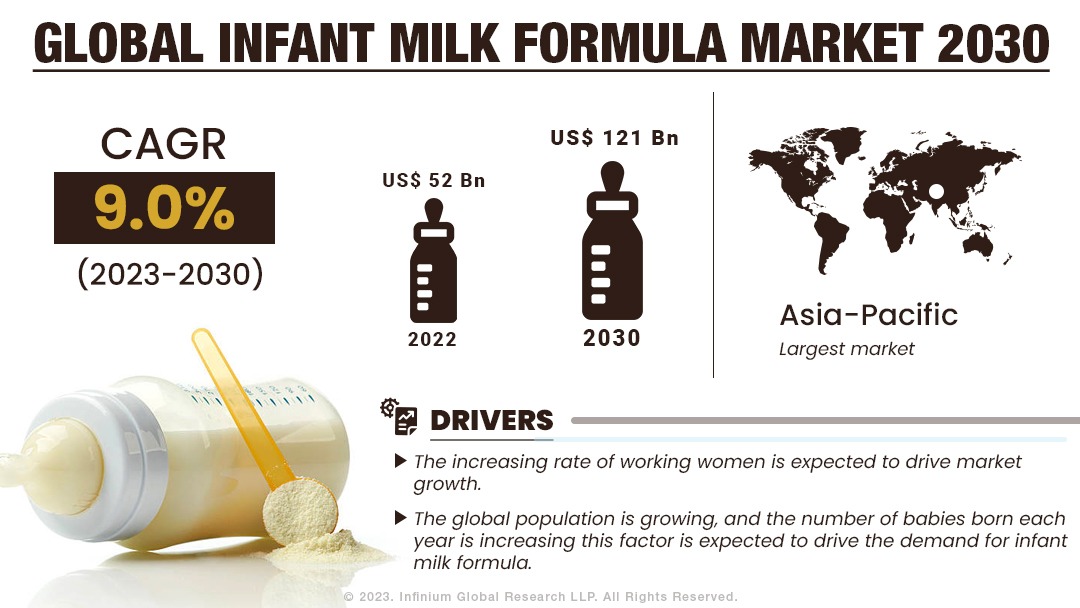Infant Milk Formula Market (Type - Infant Milk, Follow on Milk, Specialty Baby Milk, and Others; Distribution Channel - Hypermarket, Supermarkets, Medical Store, and Other): Global Industry Analysis, Trends, Size, Share and Forecasts to 2030
A recent report published by Infinium Global Research on infant milk formula market provides in-depth analysis of segments and sub-segments in the global as well as regional infant milk formula market. The study also highlights the impact of drivers, restraints, and macro indicators on the global and regional infant milk formula market over the short term as well as long term. The report is a comprehensive presentation of trends, forecast and dollar values of global infant milk formula market.
Market Insight:
Infant milk formula is a manufactured product designed to provide nutrition for infants who are not breastfed or are partially breastfed. It is a substitute for breast milk and contains a balance of nutrients, such as protein, fat, carbohydrates, vitamins, and minerals that are essential for the healthy growth and development of infants. The scope of infant milk formula includes different types of formula that are designed to meet the specific nutritional needs of infants at different stages of development. For example, there are formulas for newborns, infants with allergies or intolerances, and premature infants. Infant milk formula is typically used when breastfeeding is not possible or when there is a need for supplementation. Infant milk formula can be used in a variety of settings, such as in hospitals, childcare facilities, and at home. It is important to follow the manufacturer's instructions for preparation and storage to ensure the safety and effectiveness of the product.
The increasing rate of working women is expected to drive market growth. With more women entering the workforce, the demand for infant milk formula has increased. Working mothers may find it challenging to breastfeed their babies due to time constraints, making infant milk formula a convenient alternative. Rising birth rates significantly boost the market growth. The global population is growing, and the number of babies born each year is increasing. This drives the demand for infant milk formula, as not all mothers are able to breastfeed or choose to do so. Strict regulatory restrictions may be expected to hamper the market growth. Regulatory restrictions and changes in the regulatory environment can impact the infant milk formula market. Innovation and product differentiation of the product expected to create ample growth opportunities for the market growth.

Geographically, the global infant milk formula market is segmented as North America, Europe, Asia Pacific, and Row. The Asia-Pacific region is the largest market for infant milk formula, accounting for a significant portion of global sales. This is due to the large population and increasing disposable income in countries such as China, India, and Indonesia. Europe is also holding a significant market share of infant milk formula, with high levels of consumer awareness, and the leading manufacturer of infant milk formula. The North American market for infant milk formula is driven by a high rate of working mothers, increasing awareness of the importance of infant nutrition, and the popularity of specialized formulas for infants.
Report Scope of the Infant Milk Formula Market:
| Report Coverage | Details |
|---|---|
| Market Size in 2022 | More than USD 52 Billion |
| Market Size by 2030 | Over USD 121 Billion |
| Growth Rate from 2023 to 2030 | CAGR of Above 9% |
| Largest Market | Asia Pacific |
| No. of Pages | 180 |
| Market Drivers |
|
| Market Segmentation | By Type, and By Distribution Channel |
| Regional Scope | North America, Europe, Asia Pacific, and RoW |
Segment wise revenue contribution in the global infant milk formula market
The report on global infant milk formula market provides a detailed analysis of segments in the market based on Type, and Distribution Channel.
Segmentation Based on Type
· Infant Milk
· Follow on Milk
· Specialty Baby Milk
· Others
Segmentation Based on Distribution Channel
· Hypermarket
· Supermarkets
· Medical Store
· Other
Company Profiled:
· Abbott
· Danone
· Nestlé
· Mead Johnson & Company, LLC
· FrieslandCampina
· The Kraft Heinz Company
· Reckitt Benckiser Group PLC
· Hero Group
· Meiji Holdings Co., Ltd.
· Perrigo Company plc
Report Highlights:
The report provides deep insights into demand forecasts, market trends, and micro and macro indicators. In addition, this report provides insights into the factors that are driving and restraining the growth in this market. Moreover, The IGR-Growth Matrix analysis given in the report brings an insight into the investment areas that existing or new market players can consider. The report provides insights into the market using analytical tools such as Porter's five forces analysis and DRO analysis of the infant milk formula market. Moreover, the study highlights current market trends and provides forecasts from 2023-2030. We also have highlighted future trends in the market that will affect the demand during the forecast period. Moreover, the competitive analysis given in each regional market brings an insight into the market share of the leading players.
